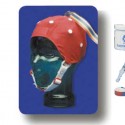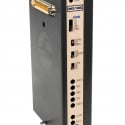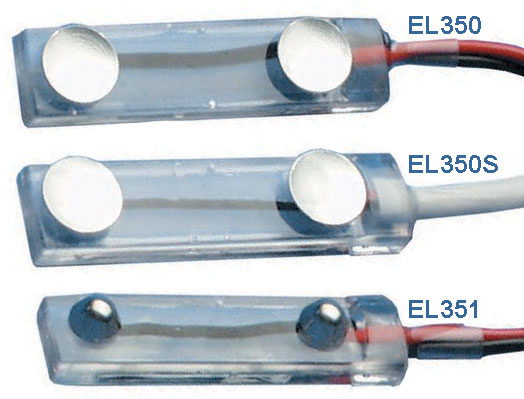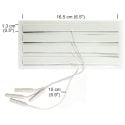External Cleaning / Disinfecting Instructions For any BIOPAC Systems data acquisition, amplifier, or accessory module: To clean the surface of the module: wipe lightly with a dry, lint-free cloth, or…
Search
An electrocardiogram (ECG) is a graphic recording of the changes occurring in the electrical potentials between different sites on the skin (leads) as a result of cardiac activity. Depolarization of…
Showing 4 of 346 products
ECG Analysis An electrocardiogram (ECG) is a graphical recording of the changes occurring in the electrical potentials between different sites on the skin as a result of cardiac activity. The…
An electrocardiogram (ECG) is a graphical recording of the changes occurring in the electrical potentials between different sites on the skin as a result of cardiac activity. The electrical activity…
The MCE100C micro-electrode amplifier module is useful for a wide range of physiological recording applications that require the use of micro-electrodes, such as cellular single channel analysis. Micro-electrodes, due to…
Cardiac Output can be determined, noninvasively, by employing electrical bio-impedance measurement techniques. Electrical bio-impedance is simply the characteristic impedance of a volume of tissue and fluid. In the case of…
Cardiac Output can be noninvasively determined by employing electrical bioimpedance measurement techniques. Electrical bioimpedance is simply the characteristic impedance of a volume of tissue and fluid. In the case of…
This application note is concerned with the recording of Zygomaticus measures using a pressure pad transducer vs. EMG electrodes during MRI or fMRI investigations. With some MRI protocols, especially those…
This application note is concerned with the recording of real-time EMG during a fMRI investigation. The following BIOPAC products were used for this measurement: MP150WSW data acquisition system with AcqKnowledge…
This application note is concerned with the recording of real-time ECG during a fMRI investigation. The following BIOPAC products were used for this measurement: MP150WSW data acquisition system with AcqKnowledge®…
IMPORTANT SAFETY NOTE When using the STMISOC, STMISOD or STMISOE stimulus isolation adapter, it is possible to generate high peak-peak voltages. These voltages are potentially damaging, especially if the high…
This application note lays out some generally recommended methods for recording data from subjects in the MRI or fMRI. BIOPAC Systems, Inc. (BIOPAC) designs systems that can be used to…
Transcranial Current Stimulation is an electrical stimulation method, which employs a direct current of value typically between 1 and 2 milliamps (ma). This method is typically oriented to neuronal stimulation in…
This application note is concerned with the implementation of subject electrical stimulation in the fMRI and MRI for the purposes of psychophysiological research. The setup presented physically limits the stimulation…
Blood Flow Measurements using the NICO100D This application note discusses Trans-Radial-Ulnar Electrical bioimpedance Velocimetry (TRUEV); measurements and analysis; the configuration discussed interrogates both the radial and ulnar (TREV >> TRUEV)…
This PRO lesson illustrates action potentials as they function through the conduction of cockroach ventral nerve cords. By administering soft puffs of air to the “anal cerci” one can provoke…
BIOPAC lets you measure physiology anywhere with innovative, compatible solutions that can be used by anyone for meaningful discovery. We make high-quality scientific tools for physiology measurement and interpretation with…
The purpose of an electrode is to act as a connector between the Subject’s skin (where electrical signals are easiest to detect) and the BIOPAC acquisition unit (via a lead…
AcqKnowledge software allows you to run a smoothing function as an online calculation or an offline transformation. There are two modes of operation for the smoothing, both use a running average…
TSD150 Series active electrodes are designed for multiple-channel surface EMG (sEMG) measurements. The units incorporate a built-in high-gain amplifier with an integral 500 Hz lowpass filter. The unique design allows…
The TSD150 Series of active electrodes interface with the HLT100C High Level Transducer interface module. The TSD150 electrodes have built-in amplification, which allows the subject to be a greater distance…
Silver-silver chloride (Ag-AgCl) electrodes provide accurate and clear transmission of surface biopotentials. EL250 series reusable lead electrodes are suitable for most applications (ECG, EEG, EGG, EMG, EOG, and ERS recordings).…
Reusable Ag-AgCl snap electrodes with 4 or 8 mm diameter and 2 mm deep gel cavity. Features for improved biopotential recordings Non-polarizable Sintered to increase electrode/electrolyte contact area Do not…
If the signal from the amplifier is not on zero, it is possible to remove the offset by using the Zero Adj screw at the top of the amplifier. Make…
Use the CBL201 to convert older amplifiers that use 2 mm pin sockets to the newer 1.5 mm touchproof connectors. This is useful if you have an older amplifier with…
Bar electrodes are recommended for use when applying a stimulus, or recording a signal, during nerve conduction, somatosensory or muscle twitch recordings. All bar electrodes are nonferrous and consist of…
Echium Oil vs. Fish Oil Food and Nutrition researchers have recently taken a look at the health benefits of stearidonic acid (SDA), an omega-3 fatty acid. It had been suggested…
Related Hardware Compatible with MP160 Smart Amplifiers NICO100D Cardiac Output, EBI100D Electrical Bioimpedance Amplifiers NICO100C Cardiac Output, EBI100C Electrical Bioimpedance MRI NICO100C-MRI Cardiac Output Amplifier Wireless BN-NICO Cardiac Output Amplifier & BN-NICO-T Transmitter Compatible with MP36 and MP36R (4-channel…
If a BioNomadix wireless physiology signal displays dropout/flatline… On a single channel Make sure transducer/lead is firmly inserted to transmitter channel, electrodes are fully adhered, and leads are not pulling…
A wireless neuro-actuator prosthetic was created using BIOPAC's wireless hardware and additional custom hardware. The electromyogram of both opponens pollicis (thumb flex) and pronator quadratus (wrist rotate) was recorded from…
MRI Solutions for Human and Animal Life Science Research Physiological Data Acquisition Systems AcqKnowledge Software—automation & specialized MRI tools Remote Monitor MRI Smart Amplifiers for cleaner signals Human-safe Isolated RF…
Distance Learning Solutions for a Hands-on Lab Experience GOLETA, California (May 21, 2020) – BIOPAC Systems announced a new solution for university level educators seeking solutions for practical lab learning…
CBS News | 60 Minutes | Brain Hacking APRIL 9, 2017| Why can’t we stop looking at our smartphones? And are the designers of the apps and content on them…
BIOPAC user Dr. Jason Braithwaite, a Cognitive Psychologist and Brain Science lecturer at England’s University of Birmingham, used a 4-channel data acquisition unit with analysis software, EDA/SCR electrodes, and body temp transducers to scientifically evaluate…
Biopac Student Lab (BSL) integrated hardware, software, and curriculum systems allow students to record data from their own bodies, animal, or tissue preps to learn principles of life science physiology.…
BIOPAC hardware and software is used by Disney's media lab to monitor web surfers and track advertising effectiveness. Read Lab Watches Web Surfers to See Which Ads WorkBy BROOKS BARNES…
BIOPAC Systems are used in top universities and global 500 companies worldwide for a wide array of life science data acquisition & analysis applications. BIOPAC experts, including academic and industry partners, have presented more than 70…
To record bipolar EEG, you will need an EEG amplifier for each pair of electrodes that you want to calculate the potential difference between. It is important to note that…
Biopac Science Lab comes with four lessons focused on brain activity: Lesson 5 — EEG I Electroencephalography: Brain Rhythms Lesson 5 introduces electroencephalographic (EEG) recording techniques. Students record EEG from the…
Build simple instrumentation amp to act as a primary interface for medical transducers, such as electrodes or bridge resistance sensors.
The BSL Hardware Guide describes how to connect and set up various signal electrodes, transducers, and other devices for use with the BSL system using an MP36, MP35, MP30,…
Hands-on, practical lab experience on or off campus, in lab or distanced! Info for Students & Instructors IMPORTANT! BSL Home is currently in English only and requires Biopac Student Lab 4.1…
A recent study added Biopac Student Lab musculoskeletal and cardiovascular physiology labs to traditional osteopathic manipulative treatment (OMT) and found that “Students' favorable feedback indicates the quality of learning in…
The BSL System includes many ECG lessons, including 12-lead ECG, cardiac output, and continuous blood pressure lessons. A heart sounds lesson allows students to listen to and record heart sounds,…
BIOPAC systems record, display and analyze data relevant to a variety of life science applications. Click a catalog title below to review the catalog online or request a printed catalog…
For certain applications, the MCE100C can perform cell transport measurements. Typically, these applications require the use of a small current applied through a pair of electrodes. By monitoring the voltage…
These disposable cloth base electrodes adhere well and are particularly useful for applications on non-conforming surfaces, such as facial EMG measurements. Due to hydrogel electrolyte concentration, these are also suitable…
Make sure the unit is turned on and connected to the computer. Check for the green circular icon next to the Start button, which indicates that the unit is connected…
BIOPAC amplifiers will connect to third-party data acquisition systems, oscilloscopes and chart recording equipment. Use the Isolated Power Supply (IPS100C) to power up to 16 BIOPAC amplifier modules. Snap amplifier…
When using calibration gas tanks with a mixing chamber—such as the AFT15 or the GASSYS2 system—an interface is required between the gas tank barbed ports and the mixing chamber’s Luer…




Stay Connected